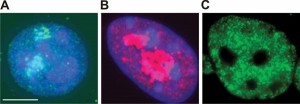
A student studies in the open spaces of the Genome Sciences Building at the University of North Carolina at Chapel Hill.
Genome organization is a layer of epigenetic information that is not encoded by DNA sequence. The objective of this project is to determine how the looping of transcriptional regulatory elements is regulated and how this ultimately impacts the expression of genes.
How do enhancers find the correct target gene?
How do insulators restrict enhancer-to-promoter DNA loops?
Our laboratory is investigating the function of DNA loops involving genes and their transcriptional regulatory elements. A major question is how a specific regulatory element finds its correct target gene and is prevented from acting on thousands of other genes in the genome. To answer this question we combine genomic approaches (ChIP-Seq, ChIA-PET) and genome editing tools (CRISPR) to study the epigenetic mechanisms by which transcriptional regulatory elements control gene expression in embryonic stem cells.

